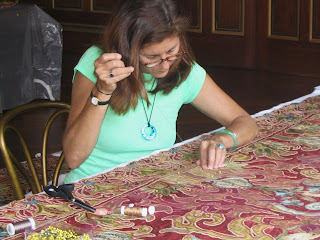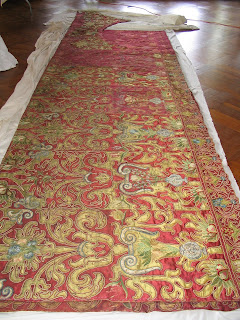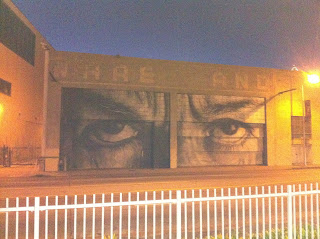Monday, November 28, 2011 -  attribution,Norway,Peter Paul Rubens
attribution,Norway,Peter Paul Rubens
 No comments
No comments
 attribution,Norway,Peter Paul Rubens
attribution,Norway,Peter Paul Rubens
 No comments
No comments
Post from Norway: Unknown Rubens work hung on the wall for 80 years at National Museum
It has just been discovered that a very valuable work, by the world renowned Dutch artist Rubens has been exhibited in Oslo’s National Museum and been part of their collection for 80 years – without them knowing about it. [This text is based solely on information from two articles; one in the Norwegian newspaper Aftenposten 19.11.2011 which unfortunately is not available on the paper's webpages yet; the other from the National televisions webpages http://www.nrk.no/kultur-og-underholdning/1.7879816.]
'This is not something that we discover every day. It is remarkable. I’m very surprised,' said Nico van Hout, a Belgian curator and Rubens expert. He had come to Norway to determine if the painted sketch was what the museum suspected: a genuine Rubens.
Until recently, the painting had been exhibited with a plaque that said “unknown Flemish artist”. It has now been attributed to the Dutch artist Peter Paul Rubens, one of the leading Flemish Baroque painters who mainly worked in the city of Antwerp.
The museum first came in contact with Nico van Hout when he visited the National Museum in conjunction with the museums Rubens exhibition during spring 2011. He immediately noticed the oil sketch, and told the museum that he thought it was very special. After his visit, van Hout and the museum kept in touch, and continued their discussions about the work and it’s provenance. He suspected that the work might be a genuine Rubens. This week van Hout was invited back to Oslo. He has been able to establish a final attribution, and has now confirmed that the work is a very good sketch by Rubens. In addition, the National Museum’s Rubens work has connections to a very important painting, "The Rape of the Daughters of Leucippus" (1617/18) at the Alte Pinakothek in Munich, according to van Hout.
'This is a great discovery, which should be internationally known because of the importance of the work,' says van Hout, and points out that the painting is a great Rubens work. 'This is a masterpiece by Rubens. It is an important work from around 1615. One of the reasons the international art world and scholars did not know about this work is because so far it has not been registered in the artist’s catalogue raisonne.'
Peter Paul Rubens's works are known for nudity, sensuality, vitality, color and speed. The National Gallery's new discovery is a good example of his work. 'This is a magnificent sketch, which really shows the life force, brushwork and speed scholars commonly associate with Rubens,' says Nico van Hout.
The scholar was asked, 'How surprised where you when you found an undiscovered Ruben’s work in Oslo?'
'I was very surprised. The National Museum is known for its great collections, but the museum does not attract the number of visitors it deserves internationally. The museum deserves greater international and national reputation.'
'I was very surprised. The National Museum is known for its great collections, but the museum does not attract the number of visitors it deserves internationally. The museum deserves greater international and national reputation.'
Nils Ohlsen, director of the department for historic and modern art at The National Museum, believes that this discovery shows how important it is to have international contacts in the art world. 'This is a joyful day for us. It proves that we have a pretty good collection also when it comes to older art. It is important to establish personal contact with other gallery owners because they might know more than us.'
Of course the art work will have a considerable increase in its value by this new authentication. Even though prices at auction houses vary, old masters such as Rubens are not often on the market.
'It is very difficult to determine the value of such a work. I do not think there are similar Rubens works on the open market today,' says Ohlsen. 'What is important for the National Museum is that we have a real Rubens work in Oslo, and that we will now be visited by several researchers who might want to write about this sketch.'
The provenance and history of The National Museums Rubens work
The painting that has now been authenticated as a genuine Rubens sketch was originally donated to the museum by the Norwegian art collector Christian Langaard. He donated his entire collection of historic international paintings to the National Gallery in Oslo, which today is part of Oslo’s National Museum of art. According to the museums current director Nils Ohlsen, Langaard meant that the painting was a genuine Rubens. But at that time scientific researchers refused to authenticate the work, and refuted that the painting was by the Flemish master Rubens. Thus the painting was incorporated into the museum collection, but was left unattributed.
'Early in the 19th century a lot of works where wrongfully attributed to Rembrandt and Rubens,' Says Ohlsen. 'After this new technical and scientific investigations where executed, and as a result of this a lot of former attributions to old masters such as Rubens and Rembrandt where then seen to be incorrect, and several works got the label “painted by unknown Flemish master” or “in the school of...” I do not know exactly who it was that examined the National Museums painting, but it was then established that it was not by Rubens.
'The painting is small, and measure only 77 x 32 cm, but the composition is filled with excitement, shadow and light,' says Ohlsen.
The National Museum hopes for more new authentications
The museum will now investigate the provenance on several other paintings in its collection, with the hope that they will discover other unauthenticated master works.
'The National Museum plans to continue this work. The museum owns several other art works that we do not know who painted. We have decided to send picture files of other works to scientists, amongst others in America,' says Ohlsen.
It is not yet certain which paintings that are to be submitted to a closer examination, but the museum has had several suggestions already from van Hout.
'He has given us suggestions about which works we should send to international scholars. And in a couple of weeks we plan to make a complete agenda and list for these new examinations,' says Ohlsen.
The attribution of works is, as the art world and art market has seen several examples of, both difficult and not precise, and neither technical tests nor the eye of a connoisseur can always be trusted. It is especially the high prices art works fetches at auctions, and the increase in value for a work if it authenticated as the work of a famous artist, that contribute to attract unserious experts and fraudsters.
However it is really great that Oslo’s National Museum has been so fortunate as to have one of the works in their collection be authenticated as a Rubens, and as one of the museum directors say, this is not something that happens everyday. But I really hope that the museum has the right connections and will seek the help of professional experts in their future plans to determine the fate and attribution of other works in the collection.
Freelance writer Therese Veier is an art historian and a lawyer and works at Public Art Norway.


















